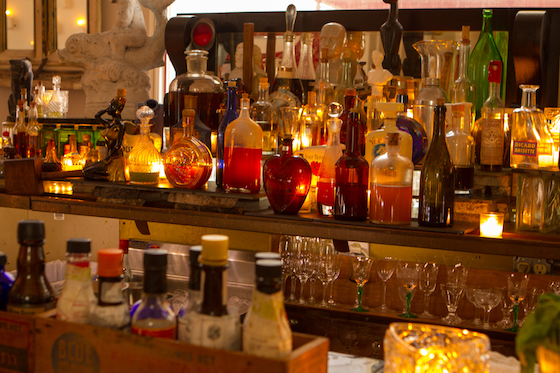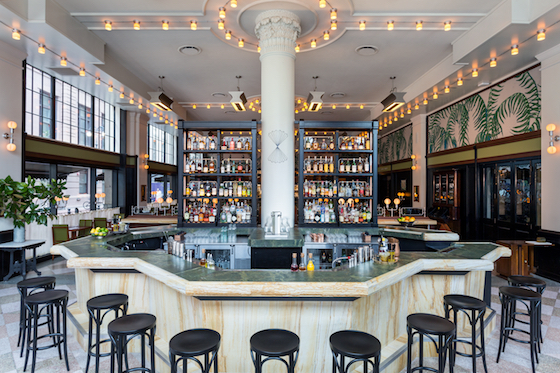New Orleans’ (often gilded, always packed-to-the-gills) hotel bars are the stuff of legend. After all, who hasn’t longed to sip a Sazerac inside its namesake Sazerac Bar at the Roosevelt Hotel, or taken a slow spin on Hotel Monteleone’s revolving Carousel Bar? The classic haunts remain sought-after for hotel guests, visitors and locals for good reason: The drinks are sippable pieces of history.
Contributed by Sarah Baird
Over the past few years, though, New Orleans has enjoyed a burst of new hotels on the scene, and inside them, a fresh wave of bars that are taking a more holistic look at the influences impacting the culinary, beverage and cultural menagerie of the city. A port town that’s been a revolving door to immigrants and transplants from across the globe for three centuries (this year is the city’s tricentennial), today in New Orleans you’ll find influences that mirror the broader scope of the city’s heritage: French and Spanish, sure, but African, South American, indigenous and more.
For Abigail Gullo, head bartender of Compère Lapin at the Old No. 77 hotel, this means tapping into the longstanding adage that New Orleans is the “Caribbean’s northernmost city.”
“I have the wonderful advantage of working in a restaurant with a Caribbean chef [Nina Compton] whose dishes are robust yet approachable,” Gullo notes. “When making cocktails, I try to complement these bold flavors by using ingredients that are native to the Caribbean, like St. Lucian rum and coconut water.”
This balancing act to complement dishes like spiced pig ears and conch fritters is deftly executed in the South Island Swizzle, which brings together both rum and rhum agricole alongside Manzanilla sherry, lime, coconut water and honey syrup (US$12, recipe, registration required). The garnish? A tiny St. Lucian flag, in honor of Compton’s home country.
‘Verdant playground’
For some fresh-arrival hotels, the balance is all about the sheer quantity of in-house bars and their unique missions. The Ace Hotel has four separate watering holes for guests, each with its own individual spirited selections and vibe, plus a separate team to handle prep of fresh juices and syrups.
“This city has such a rich drinking culture with an adventurous, curious consumer base. It’s a verdant playground where we can pour just about any spirit and people are willing to try it,” says Food and Beverage Director Andrew Jay.
When making cocktails, I try to complement these bold flavors by using ingredients that are native to the Caribbean, like St. Lucian rum and coconut water.
The Ace takes advantage of New Orleans’ nearly year-round growing season, particularly at the Lobby Bar, where the staff whips up cocktails like the Sidewalk Daiquiri (rum, pineapple, lime and cold brew). Next door, their nautically inclined restaurant, Seaworthy, features a menu rich in lower-proof drinks that are ideal for nursing alongside a tray of Gulf Coast oysters. And on the rooftop bar, Alto, there are plenty of frozen concoctions to sip poolside when the sticky heat starts to weaken guests’ resolve for wandering the streets.
The property’s flagship is Josephine Estelle. The sweeping ceilings, dark wood and Old World dining style of the Art Deco restaurant features a menu of dishes and drinks inspired by the Italian-meets-Southern influences of the city. Think mussels with ham brodo, fregola, fennel and Cerignola olives. And to nurse alongside? The Creole Apothecary is the kind of New Orleans-specific drink that doubles down on the city’s history, combining Peychaud’s aperitivo with Sazerac rye, ginger syrup, lemon and another dash of the granddaddy of New Orleans’ bitters, Peychaud’s (US$11, recipe).
“The name comes from an actual Creole apothecary [operator], Antoine Amédée Peychaud. We use Peychaud’s aperitivo in part because of its lineage, and because the flavor is so distinctly New Orleans,” notes Jay. “It’s also a combination of an Italian identity tied to a New Orleans product, which reflects what we do at Josephine Estelle — bringing a bit of Italy to the city. Unlike other Southern cities that’ve embraced bourbon, in New Orleans it’s all about rye. We added the ginger to accentuate the spiciness of the rye, and spice is certainly a characteristic that’s imbued in this city, both literally and figuratively.”

Peru via New Orleans
Tucked away in the Central Business District, the Catahoula is a diminutive hotel that still manages to create a sense of place. Guests are whisked away from a not-so-scenic stretch of parking lots as they step into the sun-dappled light slipping through the lobby windows, or retreat into the foliage-drenched courtyard.
The hotel’s flagship bar, Piscobar, doesn’t hurt, either. Since opening in 2016, Piscobar has been one of the most quietly envelope-pushing cocktail spots in the city. Bar Manager Geoff Ward isn’t afraid of whimsically presented creations that reveal the complex — and diverse — flavor pairings that pisco is capable of achieving, whether it’s a peppy lime-tinged creation that picks up on the grape-based spirit’s light mouthfeel, or a spice-laden drink looking for a spirit that has a vegetal cool.
“Pisco is a really interesting spirit, because you weren’t able to get it for a long time in the U.S.,” says Ward. “When we opened, we were one of the few pisco-focused places in the country, but now we have at least two other pisco-focused bars in New Orleans alone. I think it’s going to be like the mezcal revolution. It went from mezcal not being anywhere, to mezcal in everything. That’s going to be pisco five years down the line.”
Despite the spirit’s somersault toward the mainstream, there remains a bit of wariness about this Peruvian grape distillate among most guests.
“The American palate hasn’t been exposed to pisco much, so there’s a bit of hesitation. We have to be a bit more tour guide-like than we have to be with spirits like bourbon; we have to know where the pisco is coming from specifically,” says Ward. “It’s actually a really nice way to provide an experience where people are actively learning while they’re drinking.”
The menu also lends itself to showcasing pisco’s sweeping range — and ability to play nicely with others. There’s the Back Page, a tropical spin on the Last Word made with crème de banana and pisco that Ward describes as “something a little tiki” (US$12, recipe). The banana liqueur ensures that the drink is reminiscent of something meant to be sipped poolside, and helps bring out the fruitier qualities of the pisco when paired with equal parts lemon juice and Dolin Blanc vermouth.
Swing to the other side of the menu, and you have Ward’s much-cherished pisco and tonic, along with the Cognac Blessed, a smoother drink that combines cognac, pisco, bitters and fresh satsuma. The Pisco Fizz Yourself marries pisco-happy flavors like passion fruit, egg white and vanilla with the classic method for crafting the city’s infamous thick-and-creamy brunch cocktail: the Ramos Gin Fizz. The drink gains its gauzy lavender hue and a double-dose of Peruvian essence by way of chicha morada, a nonalcoholic purple corn-and-cinnamon beverage native to the country’s highlands (US$12, recipe).
But while loyalty to Peruvian ingredients runs deep, it’s not all pisco at the Catahoula. The bar also works to incorporate its morning coffee program into the evening cocktail menu, ensuring that hotel guests and bar visitors alike can stay quasi-caffeinated — plus or minus liquor — throughout the day. The Coffee Mixed Drink marries coffee and booze with a heavy hand, combining espresso, rum, rhubarb, amaro and vanilla. And in the Freddo Nuovo, pisco and espresso team up for what could be viewed as the ultimate Catahoula-style cocktail: a Ramazzotti and pisco coffee cube, almond and egg white.
Whether via pisco or coffee, an adherence to creating a transcendental atmosphere — morning-to-night, one drink at a time — is never far from Ward’s mind.
“Guests at the hotel love to start off their day with a nice cortado, and we were looking for a way not to let all the really nice third wave coffee we have go to waste. What better way to feature them than in cocktails in the evening?” he explains. “New Orleans is known for our rich history with coffee just as much as booze, so it’s a perfect match.”

Drinking stories
Key to the New Orleans drinking experience are the tales associated with it. And at heart, Alan Walter — like so many New Orleanians — is a storyteller.
“I want to pitch the city of New Orleans to the imagination of the guest as much as I want to put it in their mouth,” says Walter, the creative director behind Loa, inside the International House Hotel. “That means using the lay of the land to give people a literal sense of place.”
Complete with dangling, sensual lighting and enough ruby-hued velvet to make even the darkest cynic feel a twinge of romanticism, Loa’s been inviting hotel guests to learn more about the agricultural bounty of New Orleans culture — drink by drink — since before most of the city’s current cocktail dens were even a twinkle in a bartender’s eye.
“If we’re using lemons from across the river on the West Bank, or a strawberry from a certain grower in Ponchatoula, it’s all to set up the city in your mind,” Walter muses. “When people taste the fruit in the cocktail without the story to go along with it — I’m not sure that it sticks. Sure, it’s cool to feel it on your palate and smell it and all, but it’s even better to see how those things relate to the tale we’re telling about New Orleans.”
In recent years, bars across the country have developed more robust narratives around their drink menus, whether in the form of hyper-esoteric, conceptual themes like “New York 1983” or graphic novel-style tomes delving into the bar’s historical origins.
For Walter, though, it’s all about spinning a yarn. On every (seasonally rotating) menu, there’s a bit of micro-fiction: a cocktail’s origin, its personality, its ethos. In turn, the drink is allowed to morph into a character — one that’s not only contributing something to the bar experience at Loa but also to the overall drinking landscape of New Orleans.
“The menu should be a collection of things,” he remarks. “It’s a bar — you’re not going to get people reading your menu like they read a novel — but it’s a way of insinuating some liveliness. These playful stories that bring aspects of living here work well for that.”
That playfulness carries into the drinks as well: The Jala Jala Pull Pull (made with tequila, roasted local dandelion root, oregano, pineapple and Abbott’s bitters) is named after a sultry image on a prayer candle at a Treme botanica, while the Haitian Sazerac is a tribute to Haiti’s influence on New Orleans culture, with rum, plantain syrup, barrel-aged Peychaud’s bitters and Herbsaint (US$12, recipe). The Atalanta (mastiha liqueur, pressed apple juice, mezcal, egg white) is an homage to the Greek heroine of the same name who was turned into a lioness after getting caught having sex in a temple. But as the menu points out, “Hey, in mythological stories — and here on the streets of this festive city — we see this kind of thing all the time” (US$12, recipe).
It could only happen in New Orleans, a place that’s about the theater of daily life. The bars are no exception, with each hotel bar offering a stage not only to make stellar cocktails but to become a destination experience unto themselves.
“Hotels — and hotel bars — in New Orleans are usually trying to present themselves in a certain way, and trying to translate a sense of place,” muses Walter. “There tends to be something to anchor it to where you are, but make it a completely unique experience.”
This article originally ran in HOTELS sister publication, Plate.
